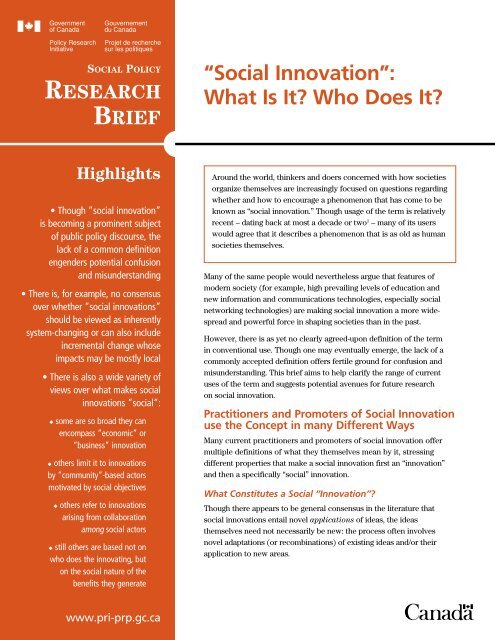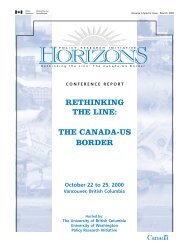"Social Innovation": What is it? Who Does it? - Horizons de politiques
"Social Innovation": What is it? Who Does it? - Horizons de politiques
"Social Innovation": What is it? Who Does it? - Horizons de politiques
You also want an ePaper? Increase the reach of your titles
YUMPU automatically turns print PDFs into web optimized ePapers that Google loves.
<strong>Social</strong> Policy<br />
Research<br />
Brief<br />
“<strong>Social</strong> Innovation”:<br />
<strong>What</strong> Is It <strong>Who</strong> <strong>Does</strong> It<br />
Highlights<br />
• Though “social innovation”<br />
<strong>is</strong> becoming a prominent subject<br />
of public policy d<strong>is</strong>course, the<br />
lack of a common <strong>de</strong>fin<strong>it</strong>ion<br />
engen<strong>de</strong>rs potential confusion<br />
and m<strong>is</strong>un<strong>de</strong>rstanding<br />
• There <strong>is</strong>, for example, no consensus<br />
over whether “social innovations”<br />
should be viewed as inherently<br />
system-changing or can also inclu<strong>de</strong><br />
incremental change whose<br />
impacts may be mostly local<br />
• There <strong>is</strong> also a wi<strong>de</strong> variety of<br />
views over what makes social<br />
innovations “social”:<br />
u some are so broad they can<br />
encompass “economic” or<br />
“business” innovation<br />
u others lim<strong>it</strong> <strong>it</strong> to innovations<br />
by “commun<strong>it</strong>y”-based actors<br />
motivated by social objectives<br />
u others refer to innovations<br />
ar<strong>is</strong>ing from collaboration<br />
among social actors<br />
u still others are based not on<br />
who does the innovating, but<br />
on the social nature of the<br />
benef<strong>it</strong>s they generate<br />
Around the world, thinkers and doers concerned w<strong>it</strong>h how societies<br />
organize themselves are increasingly focused on questions regarding<br />
whether and how to encourage a phenomenon that has come to be<br />
known as “social innovation.” Though usage of the term <strong>is</strong> relatively<br />
recent – dating back at most a <strong>de</strong>ca<strong>de</strong> or two 1 – many of <strong>it</strong>s users<br />
would agree that <strong>it</strong> <strong>de</strong>scribes a phenomenon that <strong>is</strong> as old as human<br />
societies themselves.<br />
Many of the same people would nevertheless argue that features of<br />
mo<strong>de</strong>rn society (for example, high prevailing levels of education and<br />
new information and communications technologies, especially social<br />
networking technologies) are making social innovation a more wi<strong>de</strong>spread<br />
and powerful force in shaping societies than in the past.<br />
However, there <strong>is</strong> as yet no clearly agreed-upon <strong>de</strong>fin<strong>it</strong>ion of the term<br />
in conventional use. Though one may eventually emerge, the lack of a<br />
commonly accepted <strong>de</strong>fin<strong>it</strong>ion offers fertile ground for confusion and<br />
m<strong>is</strong>un<strong>de</strong>rstanding. Th<strong>is</strong> brief aims to help clarify the range of current<br />
uses of the term and suggests potential avenues for future research<br />
on social innovation.<br />
Pract<strong>it</strong>ioners and Promoters of <strong>Social</strong> Innovation<br />
use the Concept in many Different Ways<br />
Many current pract<strong>it</strong>ioners and promoters of social innovation offer<br />
multiple <strong>de</strong>fin<strong>it</strong>ions of what they themselves mean by <strong>it</strong>, stressing<br />
different properties that make a social innovation first an “innovation”<br />
and then a specifically “social” innovation.<br />
<strong>What</strong> Const<strong>it</strong>utes a <strong>Social</strong> “Innovation”<br />
Though there appears to be general consensus in the l<strong>it</strong>erature that<br />
social innovations entail novel applications of i<strong>de</strong>as, the i<strong>de</strong>as<br />
themselves need not necessarily be new: the process often involves<br />
novel adaptations (or recombinations) of ex<strong>is</strong>ting i<strong>de</strong>as and/or their<br />
application to new areas.<br />
www.pri-prp.gc.ca
“<strong>Social</strong> Innovation”: <strong>What</strong> Is It <strong>Who</strong> <strong>Does</strong> It<br />
There also tends to be a “systems” focus among users of the concept – that <strong>is</strong>, an interest in social<br />
innovation as a mechan<strong>is</strong>m for achieving systemic change to society as a whole – typically w<strong>it</strong>h a<br />
view to tackling the un<strong>de</strong>rlying causes of social problems rather than just alleviating their symptoms.<br />
There <strong>is</strong> less agreement, however, on how wi<strong>de</strong>spread an innovation should be (or the magn<strong>it</strong>u<strong>de</strong> or<br />
time frame of <strong>it</strong>s impacts) for <strong>it</strong> to be properly consi<strong>de</strong>red a social “innovation”, w<strong>it</strong>h some explic<strong>it</strong>ly<br />
d<strong>is</strong>counting adaptive changes or those w<strong>it</strong>h impacts lim<strong>it</strong>ed to a particular locale or context, and others<br />
viewing d<strong>is</strong>tinctions between d<strong>is</strong>ruptive, systemic innovations and incremental, context-specific changes<br />
as inherently subjective. 2<br />
Moreover, even promoters of a radical or system-changing interpretation of the term often make<br />
reference to examples that, to many, may appear gradual or local in nature (Figure 1).<br />
Figure 1<br />
<strong>Social</strong> “Innovation”: “Systemic and D<strong>is</strong>ruptive” Versus “Context-Specific and Adaptive”<br />
“Systemic”<br />
change<br />
Gradual<br />
or “adaptive”<br />
change<br />
… though many of<br />
the anecdotal examples they c<strong>it</strong>e<br />
seem to be (relatively) mo<strong>de</strong>st<br />
adaptations tied to fairly specific<br />
(often local) contexts<br />
Many (though not all)<br />
authors focus on radical<br />
(i.e., d<strong>is</strong>ruptive, systemic)<br />
change in <strong>de</strong>scribing and<br />
promoting the concept<br />
D<strong>is</strong>continuous<br />
or “d<strong>is</strong>ruptive”<br />
change<br />
Context specific<br />
change<br />
<strong>What</strong>’s “<strong>Social</strong>” about <strong>Social</strong> Innovation<br />
In add<strong>it</strong>ion to a multiplic<strong>it</strong>y of views on what const<strong>it</strong>utes an innovation, there are a number of different<br />
strands of thought on what makes social innovations specifically “social” and, in particular, which social<br />
actors (commun<strong>it</strong>y-based organizations or informal networks, businesses, governments, etc.) are involved<br />
in the process, and how:<br />
2
“<strong>Social</strong> Innovation”: <strong>What</strong> Is It <strong>Who</strong> <strong>Does</strong> It<br />
• Some <strong>de</strong>fin<strong>it</strong>ions of social innovation – for example,<br />
“new i<strong>de</strong>as that work” or “[changes to] routines,<br />
resource and author<strong>it</strong>y flows or beliefs in any social<br />
system” 3 – are so broad that they can encompass the<br />
more familiar concepts of “business” or “economic”<br />
innovation (and even innovations in how governments<br />
carry out their activ<strong>it</strong>ies) since they too – like<br />
“commun<strong>it</strong>y”-based innovators who are often the<br />
main focus of those analyzing and promoting social<br />
innovation – are social actors who are embed<strong>de</strong>d<br />
in and/or overlap w<strong>it</strong>h broa<strong>de</strong>r social structures<br />
and networks.<br />
• Other <strong>de</strong>fin<strong>it</strong>ions – for example, “[innovations that<br />
are] predominantly <strong>de</strong>veloped and diffused through<br />
organ<strong>is</strong>ations whose primary purposes are social” 4 –<br />
grav<strong>it</strong>ate toward a much narrower view based on a<br />
sharp d<strong>is</strong>tinction between “economic” and “social”<br />
innovations, w<strong>it</strong>h the latter being the preserve of<br />
non-business (“commun<strong>it</strong>y”) actors motivated by<br />
fundamentally different objectives than business<br />
(or, implic<strong>it</strong>ly, governments).<br />
• Others still – for example, “[innovations] that<br />
draw from, and appear at the intersection of, the<br />
commun<strong>it</strong>y, business and government sectors” 5 –<br />
see innovations as social when they are produced<br />
through the collaboration of multiple different social<br />
actors, usually when commun<strong>it</strong>y sector organizations<br />
partner w<strong>it</strong>h businesses (or governments) in<br />
<strong>de</strong>veloping new approaches to tackling unmet or<br />
emerging needs.<br />
• Other <strong>de</strong>fin<strong>it</strong>ions – for example, “[innovations] for<br />
which the value created accrues primarily to<br />
society as a whole rather than private<br />
individuals” 6 – <strong>de</strong>marcate social innovations along<br />
an (inev<strong>it</strong>ably somewhat fuzzy) dividing line<br />
between those that generate predominantly private<br />
benef<strong>it</strong>s from those whose benef<strong>it</strong>s are predominantly<br />
public or social. That <strong>is</strong>, the appropriate test<br />
here <strong>is</strong> not based on who <strong>is</strong> doing the innovating<br />
(though there <strong>is</strong> a presumption that most such<br />
innovations will involve the commun<strong>it</strong>y sector as<br />
key players) but on the fru<strong>it</strong>s they yield.<br />
“Economic”<br />
(or “business”)<br />
“Economic”<br />
innovation<br />
(or “Economic” “business”)<br />
(or innovation<br />
“Economic” “business”)<br />
(or innovation “business”)<br />
innovation<br />
“Economic”<br />
(or “business”)<br />
“Economic”<br />
innovation<br />
(or “Economic” “business”)<br />
(or innovation<br />
“Economic” “business”)<br />
(or innovation “business”)<br />
innovation<br />
(Very) broadly <strong>de</strong>fined<br />
“social” innovation<br />
(Very) broadly <strong>de</strong>fined<br />
(Very) “social” broadly innovation <strong>de</strong>fined<br />
(Very) “social” broadly innovation <strong>de</strong>fined<br />
“social” innovation<br />
Innovation<br />
Innovation<br />
Innovation<br />
Innovation<br />
“Economic”<br />
(or “business”)<br />
“Economic”<br />
innovation<br />
(or “Economic” “business”)<br />
(or innovation<br />
“Economic” “business”)<br />
(or innovation “business”)<br />
innovation<br />
Innovation<br />
Innovation<br />
Innovation<br />
Innovation<br />
“<strong>Social</strong>”<br />
innovation<br />
“<strong>Social</strong>”<br />
innovation<br />
“<strong>Social</strong>”<br />
innovation<br />
“<strong>Social</strong>”<br />
innovation<br />
(Narrowly<br />
<strong>de</strong>fined)<br />
(Narrowly<br />
“social”<br />
<strong>de</strong>fined)<br />
innovation (Narrowly<br />
“social”<br />
(Narrowly <strong>de</strong>fined)<br />
innovation “social” <strong>de</strong>fined)<br />
innovation “social”<br />
innovation<br />
Commun<strong>it</strong>y<br />
innovation<br />
Commun<strong>it</strong>y<br />
Commun<strong>it</strong>y innovation<br />
Commun<strong>it</strong>y innovation<br />
innovation<br />
Commun<strong>it</strong>y<br />
innovation<br />
Commun<strong>it</strong>y<br />
Commun<strong>it</strong>y innovation<br />
Commun<strong>it</strong>y innovation<br />
innovation<br />
“Economic”<br />
Predominantly private benef<strong>it</strong>s<br />
(or “business”)<br />
“Economic”<br />
Predominantly private benef<strong>it</strong>s<br />
innovation<br />
(or “Economic” “business”)<br />
Predominantly private benef<strong>it</strong>s<br />
(or innovation<br />
“Economic” “business”)<br />
Predominantly private benef<strong>it</strong>s<br />
(or innovation “business”)<br />
innovation “<strong>Social</strong>” innovation<br />
“<strong>Social</strong>” innovation<br />
“<strong>Social</strong>” innovation Commun<strong>it</strong>y<br />
“<strong>Social</strong>” innovation innovation<br />
Commun<strong>it</strong>y<br />
Predominantly public or social benef<strong>it</strong>s<br />
Commun<strong>it</strong>y innovation<br />
Predominantly public or social benef<strong>it</strong>s<br />
Commun<strong>it</strong>y innovation<br />
Predominantly public or social benef<strong>it</strong>s<br />
innovation<br />
Predominantly public or social benef<strong>it</strong>s<br />
3
“<strong>Social</strong> Innovation”: <strong>What</strong> Is It <strong>Who</strong> <strong>Does</strong> It<br />
Questions for Further Research<br />
Some authors argue 7 that a useful <strong>de</strong>fin<strong>it</strong>ion of what const<strong>it</strong>utes “social innovation” will entail making<br />
some kind of d<strong>is</strong>tinction between social and other (e.g., business or economic) innovations – notably<br />
in or<strong>de</strong>r to help policy makers d<strong>is</strong>tingu<strong>is</strong>h between those innovations where significant market-driven<br />
incentives ex<strong>is</strong>t and those where different (though not necessarily less powerful) incentives are at play.<br />
W<strong>it</strong>h th<strong>is</strong> in mind, the following may be worthwhile policy research questions to pursue, based<br />
on the assumption that the relevant concept of social innovation for policy makers <strong>is</strong> one that<br />
encompasses innovations:<br />
• resulting from e<strong>it</strong>her unilateral or collaborative actions across a range of different social actors;<br />
• whose impacts can be expected to generally result in social benef<strong>it</strong>s (that <strong>is</strong>, that accrue primarily<br />
to others); and<br />
• whose impacts may range from context-specific and incremental changes to changes that are societal<br />
in scope and potentially d<strong>is</strong>ruptive (or “game-changing”).<br />
<strong>What</strong> (if anything) <strong>is</strong> changing or has changed w<strong>it</strong>hin contemporary society that <strong>is</strong> acting<br />
to increase the appet<strong>it</strong>e for – or capac<strong>it</strong>y to generate – social innovations<br />
<strong>What</strong> (if any) are the key differences between social innovation and other kinds of<br />
innovation in relation to:<br />
• the genes<strong>is</strong> of creative or innovative i<strong>de</strong>as that form the germ of subsequent innovations<br />
• the process of converting such i<strong>de</strong>as into concrete real<strong>it</strong>ies “on the ground”<br />
• the ease w<strong>it</strong>h which concrete innovations can be ma<strong>de</strong> wi<strong>de</strong>spread or “scaled up”<br />
• the ease w<strong>it</strong>h which they can be adapted to different contexts and/or meet different needs<br />
<strong>What</strong> kinds of policy interventions are most likely to be successful in facil<strong>it</strong>ating<br />
specifically social innovations (and how do they differ from those that facil<strong>it</strong>ate<br />
economic or business innovations)<br />
1<br />
An early use of the term – in an explic<strong>it</strong>ly economic context – was by Kuznets in 1974 (quoted in Pol et. al, 2009).<br />
2<br />
Compare, for example, Mulgan and the Centre for <strong>Social</strong> Innovation, on the one hand, and Phills et al. (2008), on the other.<br />
3<br />
Cf. Mulgan (2007), p.8 and Westley (2008), p.2., respectively. Other examples are those of Scott (2007), p.xiv., and<br />
Gol<strong>de</strong>nberg et al. (2009), p. 3.<br />
4<br />
Cf. the second <strong>de</strong>fin<strong>it</strong>ion by Mulgan (2007), p.8. Other examples are those proffered by He<strong>is</strong>kala (2007), p.74., and by the<br />
European Union’s Katars<strong>is</strong> project (2009).<br />
5<br />
Cf. Australian <strong>Social</strong> Innovation Exchange (2008), p.1.<br />
6<br />
Cf. Phills et al. (2008), p.36. A variant on th<strong>is</strong> <strong>de</strong>fin<strong>it</strong>ion (for example, Mulgan’s second <strong>de</strong>fin<strong>it</strong>ion (op. c<strong>it</strong>.): innovations<br />
4<br />
“motivated by the goal of meeting a social need”) <strong>is</strong> one based on motivations, as d<strong>is</strong>tinct from actual benef<strong>it</strong>s.<br />
7<br />
Cf. Pol et al. (2009).
“<strong>Social</strong> Innovation”: <strong>What</strong> Is It <strong>Who</strong> <strong>Does</strong> It<br />
References/Suggested Reading<br />
Australian <strong>Social</strong> Innovation Exchange. 2008. “<strong>Social</strong> Innovation at the Heart of Australia’s National<br />
Innovation System,” subm<strong>is</strong>sion to Review of the National Information System, April.<br />
Centre for <strong>Social</strong> Innovation. nd. “<strong>Social</strong> Innovation.” Retrieved January 21, 2010 at<br />
.<br />
Chr<strong>is</strong>tensen, Clayton M., et al. 2006. “D<strong>is</strong>ruptive Innovation for <strong>Social</strong> Change,” Harvard Business Review.<br />
December: 94-101.<br />
Damon, Julien, et al. 2009. “Pol<strong>it</strong>iques sociales : dix innovations venues d’ailleurs.” Par<strong>is</strong>: Futuribles<br />
International.<br />
European Union. 2009. “Tackling <strong>Social</strong> Exclusion through <strong>Social</strong> Innovation: Strategy Research Options.”<br />
European Policy Brief, EU Katars<strong>is</strong> project.<br />
Gol<strong>de</strong>nberg, Mark et al. 2009. <strong>Social</strong> Innovation in Canada: An Update. Ottawa: Canadian Policy<br />
Research Networks.<br />
Hamalainen, Timo. et al. 2007. <strong>Social</strong> Innovations, Inst<strong>it</strong>utional Change and Economic Performance.<br />
Cheltenham, UK: Edward Elgar.<br />
He<strong>is</strong>kala, R., 2007. <strong>Social</strong> innovations: structural and power perspectives. In: Hamalainen, T.J. He<strong>is</strong>kala, R.<br />
(Eds.), <strong>Social</strong> Innovations, Inst<strong>it</strong>utional Change and Economic Performance. Edward Elgar, Cheltenham,<br />
pp. 52–79.<br />
Moulaert, Frank, and Jean Hillier. 2009. “<strong>What</strong> Is <strong>Social</strong> Innovation And Why Is <strong>it</strong> Pol<strong>it</strong>ically Relevant”<br />
Presentation at a policy d<strong>is</strong>semination workshop t<strong>it</strong>led <strong>Social</strong> Innovation: An Opportun<strong>it</strong>y for Europe,<br />
Brussels, Belgium, October 7. Retrieved at .<br />
Mulgan, Geoff, et al. 2007. “<strong>Social</strong> Innovation: <strong>What</strong> <strong>it</strong> Is, Why <strong>it</strong> Matters and How <strong>it</strong> Can Be Accelerated.”<br />
Working paper, Skoll Centre for <strong>Social</strong> Entrepreneurship, Saïd Business School, Univers<strong>it</strong>y of Oxford.<br />
Organ<strong>is</strong>ation for Economic Co-operation and Development. nd. “OECD LEED Forum on <strong>Social</strong> Innovations.”<br />
Retrieved at .<br />
Phills, James A., et al. 2008. “Red<strong>is</strong>covering <strong>Social</strong> Innovation,” Stanford <strong>Social</strong> Innovation Review.<br />
Fall 34-43.<br />
Pol, Eduardo, et al. 2009. “<strong>Social</strong> Innovation: Buzz Word or Enduring Term,”<br />
The Journal of Socio-Economics. No. 38: 878-885.<br />
Scott, R. 2007. Prefatory chapter: inst<strong>it</strong>utions and social innovation. In: Hamalainen, T.J., He<strong>is</strong>kala, R. (Eds.),<br />
<strong>Social</strong> Innovations, Inst<strong>it</strong>utional Change and Economic Performance. Edward Elgar, Cheltenham, pp. viii–xxi.<br />
Westley, Frances. 2008. “The <strong>Social</strong> Innovation Dynamic.” Waterloo, ON: <strong>Social</strong> Innovation Generation/<br />
SiG@Waterloo.<br />
5











